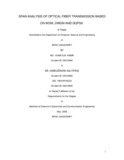| dc.contributor.author | Kabir, Humayun | |
| dc.contributor.author | Faruq, Asaduzzaman All | |
| dc.contributor.author | Reza, Tanvir | |
| dc.date.accessioned | 2010-09-22T06:46:59Z | |
| dc.date.available | 2010-09-22T06:46:59Z | |
| dc.date.copyright | 2008 | |
| dc.date.issued | 2008-05 | |
| dc.identifier.other | ID 06310046 | |
| dc.identifier.other | ID 05310050 | |
| dc.identifier.other | ID 05210035 | |
| dc.identifier.uri | http://hdl.handle.net/10361/190 | |
| dc.description | This thesis report is submitted in partial fulfillment of the requirements for the degree of Bachelor of Science in Computer Science and Engineering, 2008. | en_US |
| dc.description | Cataloged from PDF version of thesis report. | |
| dc.description | Includes bibliographical references (page 52). | |
| dc.description.abstract | Today’s world depending on frequent data communication, optical fiber is the
most frequent physical backbone to transferring carrier information and
sometimes it is distorted, attenuated and losses of information. Span analysis is
the calculation and verification of a fiber-optic system's operating characteristics.
This includes items such as fiber routing, electronics, wavelengths, fiber type,
and circuit length. Attenuation and nonlinear considerations are the key
parameters for loss-budget analysis.
Demandable ultra-wideband transmission over the Internet, Transmission
techniques is now measured to be very important. Hence, upgrading current RZ-
10Gbps DWDM optical systems with 40 Gbps channels multiplexed with
accessible traffic infrastructure we can enlarge the capacity to Terabit/s with
minimum advancement tasks. We apply the DPQPSK transmission technique of
single light wave channel over optical fiber communication systems. It has
capability to double the bit-rate compared to usual OOK signaling techniques.
For simulation we apply the block sets of communication and signal processing
of the Matlab ™ Simulink. A high-capacity 20 Gbps (2 * 10 Gbps) and 40 Gbps
(40*10 Gbps) can be extended from 10Gb/s channels. Theoretical background of
the design of the optical DQPSK system is given. Detailed operation and purpose
of each component model and its outcomes in Simulink Block sets are explained.
Future plane which support DWDM operation to allow Tbps transmission with N x
40 Gbps systems are also draw round. | en_US |
| dc.description.statementofresponsibility | Asaduzzaman All Faruq | |
| dc.description.statementofresponsibility | Tanvir Reza | |
| dc.description.statementofresponsibility | Humayun Kabir | |
| dc.format.extent | 58 pages | |
| dc.publisher | BRAC University | en_US |
| dc.rights | BRAC University thesis are protected by copyright. They may be viewed from this source for any purpose, but reproduction or distribution in any format is prohibited without written permission. | |
| dc.subject | Computer science and engineering | |
| dc.title | Span analysis of optical fiber transmission based on WDM , DWDM and DQPSK | en_US |
| dc.type | Thesis | en_US |
| dc.contributor.department | Department of Computer Science and Engineering, BRAC University | |
| dc.description.degree | B. Computer Science and Engineering | |

